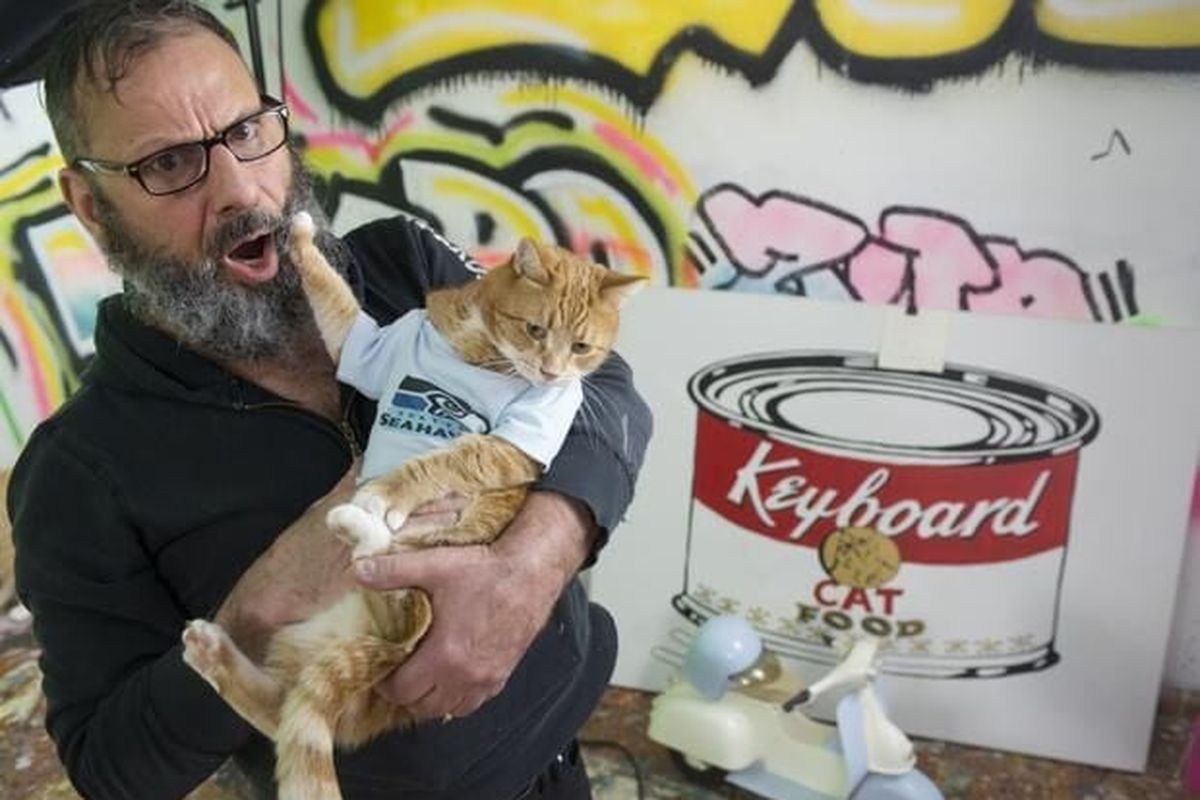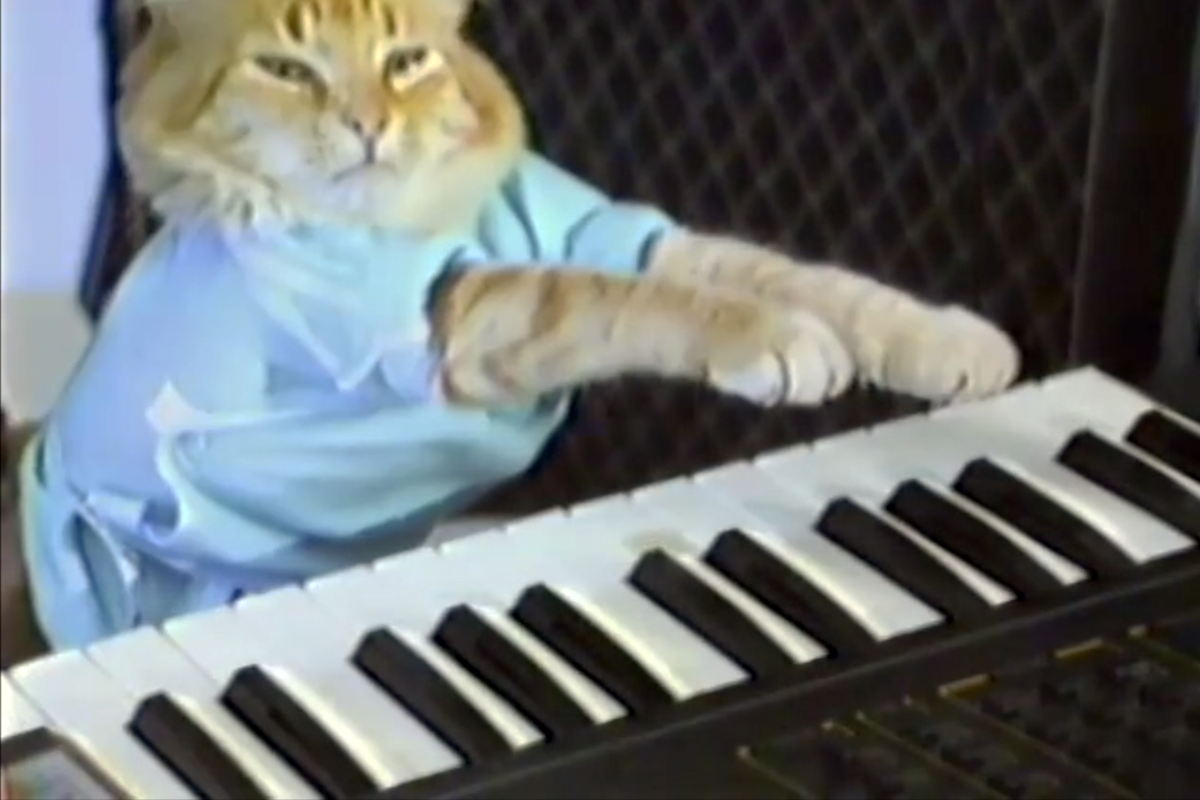Charlie Schmidt, a Spokane original, will be the focus of a documentary
Charlie Schmidt and Keyboard Cat will be featured in a documentary that started filming last week in Spokane. Cameras will be rolling Tuesday when Schmidt has a one-man art show at the Kolva-Sullivan Gallery. (Courtesy)
Charlie Schmidt is well aware that truth is stranger than fiction. The South Hill artist has plenty of anecdotes to back that up.
While working as the art director at KREM during the mid-1970s, a child on a tour of the television station asked how Schmidt scored the job.
“I told the kid that I had to pretend that I had a degree in graphic design and I had to tuck my long hair under a wig to get the job,” Schmidt said. “That’s the way it was.”
Schmidt, 72, who scored the television gig after studying art in Japan, had hair down to his waist during his 20s. “So I tucked all of my hair under this wig. I kept it that way until I was doing some painting on the stage set and got green paint on the wig. I revealed to the folks at KREM that I had long hair. They were shocked. They kept me. They liked my work. The people at KREM still tell that story.”
Director Andre Relis will be telling a long form Schmidt story. The former member of the punk band Rubberneck started shooting “Keyboard Cat: Anatomy of a Meme,” a documentary on Schmidt, Friday in Spokane.
Relis will capture footage at Schmidt’s art show, which is the same name as his film, Tuesday at the Kolva-Sullivan Gallery, where a variety of his provocative visual art will be displayed.
“I’m excited about the art show but I’m also excited about the film.”
Relis, who has known Schmidt for years, came up with the concept just before the pandemic. “Andre approached me about making the Keyboard Cat movie,” Schmidt said. “I said yes and the day we were going to start shooting, the pandemic arrived. I never thought it would happen once the pandemic stuck around. But the Keyboard Cat documentary is happening.”
The title is a reference to Schmidt’s entertaining ‘90s video featuring Fatso, the iconic Keyboard Cat. The video, which features a cat playing the piano, went viral, amassing over 100 million views and has become a ubiquitous meme. The Keyboard Cat – a replacement, actually, since the original cat had died – was featured in a YouTube television commercial that aired during the Super Bowl.
“We didn’t know when the commercial would air during the Super Bowl,” Schmidt said. “When it finally aired it was like the cherry on top of the sundae.”
It’s been a fascinating career for Schmidt who earned acclaim after developing the “Dancing Nose” video. The humorous art earned him three invitations on “The Tonight Show with Jay Leno.”
“That was a great experience,” Schmidt said. “Jay Leno is one of the nicest people you’ll ever meet. He’s a humble everyman.”
The nose video broke during the early ’90s –before YouTube – thanks to a video song contest on KXLY. The clip won first prize.
“I got 12 free video rentals,” Schmidt said. “KXLY said they were going to send the video to a Hollywood producer. Yeah, like anything was going to happen.”
However, two days later, a Hollywood producer, Bob Booker, who produced a number of television variety shows, including “The NBC Follies,” contacted Schmidt. “I never expected to have anyone reach out to me,” Schmidt said. “But I look at life like you’re purchasing a lottery ticket. My life has been like winning the lottery. How could a guy from Spokane get on “The Tonight Show” because of what I did with a nose? You put yourself out there and things can happen.”
The Gonzaga Prep alum, class of ‘69, has been a freelance graphic artist since leaving KREM in 1976. “It’s been a fantastic career,” Schmidt said. “I’ve been able to do what I want.”
Schmidt is a viral sensation, who has lived in Tokyo, Los Angeles and New York, so why does Schmidt remain in Spokane? “That’s a good question,” Schmidt said. “I’ve been working on that answer for years. It just feels right here. When I go to other places, it’s like going into a hot tub. It feels great initially but then it gets hotter and hotter and you want to get out. I have a feeling about this town I can’t explain. Spokane is pretty cool. I’m just amazed that I ended up here since all four of my grandparents were from Europe. I can’t explain why they came to Spokane. They barely spoke English and they were very poor. But they made a great decision. They came to Spokane. I’m staying here. It’s a great place to make art.”

